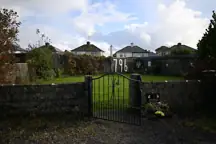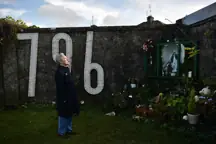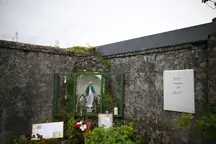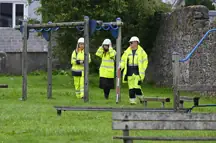With work underway to excavate the remains of nearly 800 infants at a mother and baby home in Ireland, here is everything we know.

A forensic excavation is now underway in Tuam, County Galway, where it's believed that 796 infants were buried in secret under a former "mother and baby" home - many in a disused septic tank, per the Guardian.
The chilling story was uncovered by the tireless work of local historian Catherine Corless, whose discovery in 2014 shocked the world and forced a nation to confront its cruel past.
A Hidden Grave Beneath a Town’s FeetTuam’s St Mary’s Home, operated by the Bon Secours Sisters, ran from 1925 until 1961. It was meant to provide shelter to unmarried mothers and their babies - women shunned by society and condemned by religious norms.
In reality, it became a chamber of horrors.
Between measles, tuberculosis, and rampant malnutrition, children died at horrifying rates - on average, one every two weeks for nearly four decades.
But only two children were ever given marked burials. The rest were "discarded," as Corless described it.
“There are so many babies, children just discarded here,” she told Agence France-Presse.
She added in an interview with Sky News: “I'm feeling very relieved. It's been a long, long journey. Not knowing what's going to happen, if it's just going to fall apart or if it's really going to happen.”
The cruelty wasn’t just systemic - it was personal.
Annette McKay, now 71 and born in Tuam, has waited her whole life for this excavation.
Her half-sister Mary Margaret died at six months old after being born in the home in 1942.
She shared her mother's harrowing memory: “She was pegging washing out and a nun came up behind her and said ‘the child of your sin is dead.’”
Annette now dreams of a dignified burial for Mary Margaret: “I don't care if it's a thimbleful [of remains]… That's fitting.”

Corless's revelations prompted the Irish government to form a Commission of Investigation, which confirmed that a chambered structure containing the remains of infants was indeed an old sewage tank.
The discovery stunned the country and drew condemnation across the globe.
“The church preached to look after the vulnerable, the old and the orphaned, but they never included illegitimate children for some reason or another in their own psyche," Corless said.
"I never, ever understand how they could do that to little babies, little toddlers. Beautiful little vulnerable children.”
The commission’s findings led to a state apology in 2021.
Then-Taoiseach Micheál Martin admitted Ireland’s past was marred by a “completely warped attitude to sexuality and intimacy,” saying mothers and children paid “a terrible price.”
The Bon Secours Sisters also acknowledged that the children were “buried in a disrespectful and unacceptable way.”

Excavation crews sealed off the site in mid-June 2025, ahead of full excavation beginning July 14. It follows years of planning and is led by Daniel McSweeney, head of the Office of the Director of Authorised Intervention Tuam (ODAIT), per BBC News.
He called it a “unique and incredibly complex excavation.”
He went on: "Substantial and meaningful planning has gone into this unique and incredibly complex excavation.
“It’s an incredibly complex challenge because of the size of the site and the fact that we are dealing with infant remains that we know, at least in the case of the memorial gardens (on the site), are co-mingled.”
Despite the emotional weight, the mission is clear: Identify the remains, conduct DNA testing, and offer each child a dignified reburial.
“Our work is centred around the people and groups who have been most impacted by the former mother-and-baby institution in Tuam. This includes families, survivors and the Tuam community," McSweeney continued.
"Our work will be conducted in accordance with international standards and best practice, and in keeping with our core values.
"As the site will be forensically sealed at all times during the excavation, we are hoping to facilitate on-site visits for survivors and family members at the beginning of the excavation.”
The site, now surrounded by hoarding in the middle of a modern housing estate, may also contain victims from the Great Famine, adding another layer of complexity to the task.

Long before the official recognition, the horror was hiding in plain sight. In 1975, two boys stumbled upon skeletal remains while playing near the old home, but officials at the time brushed it off as a famine-era burial.
Only decades later did the truth rise to the surface. In 2017, then-Taoiseach Enda Kenny described Tuam bluntly: “A chamber of horrors.”
